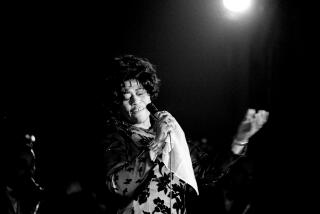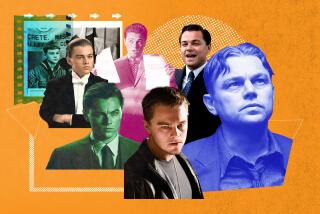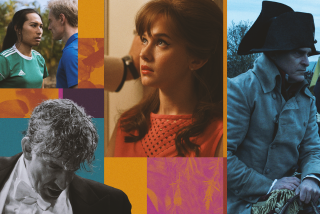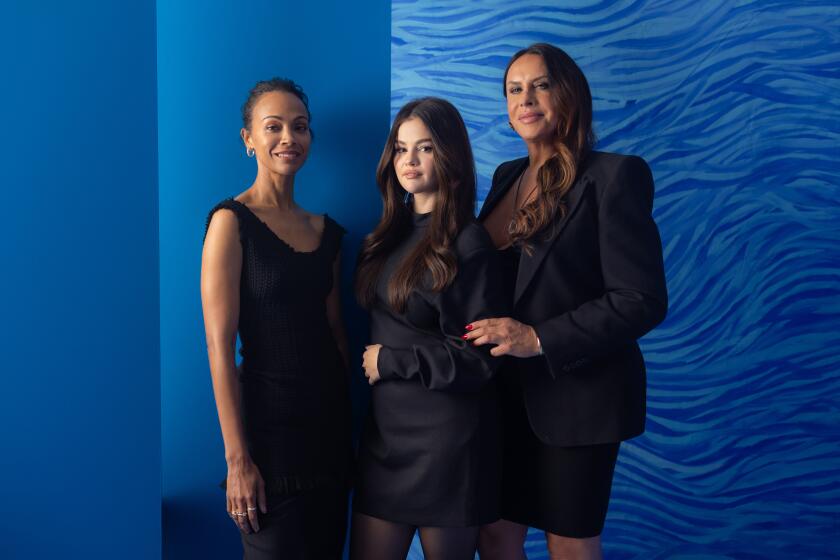Review: ‘Gatsby’s’ substance overwhelmed by Luhrmann’s style
- Share via
“The Great Gatsby” began on paper, with F. Scott Fitzgerald’s celebrated novel, and on paper “Gatsby” sounds like quite the film. On screen, though, things start to fall apart.
Directed by razzle-dazzle impresario Baz Luhrmann, this “Gatsby” boasts the charismatic duo of Leonardo DiCaprio and Carey Mulligan as romantic leads, 3-D as its format, a soundtrack rife with proven hitmakers, a Jazz Age setting and a theme of the American Dream gone sour that still resonates today. Whatever could go wrong? With some exceptions, a whole lot.
Though it is gorgeously written and often cited as one of the great American novels, Fitzgerald’s “Gatsby” is in fact very much a slender reed, a tragedy in a minor key. What’s problematic in Luhrmann’s version is that while his screenplay (co-written with frequent collaborator Craig Pearce) takes pains to parallel the book’s tale of Jay Gatsby’s star-crossed love for Daisy Buchanan, his filmmaking point of view suffocates beyond resuscitation any dramatic interest the story might have generated.
PHOTOS: ‘The Great Gatsby’ premiere
The director has steadfastly proclaimed his passion for the novel, but the film he’s made of it too often plays as no more than an excuse to display his frantic, frenetic personal style. A filmmaker who has increasingly made a fetish of excess and a religion of artificiality, Luhrmann and his team (“Moulin Rouge,” “Romeo + Juliet”) pile on the spectacle and the glitter until we are gasping for air. It’s all so chaotic that the fact that the soundtrack is filled with anachronistic songs by 21st century performers like Jay-Z and Lana Del Rey barely registers.
A parallel problem, as if this film needed one, is that Luhrmann’s direction of his actors cudgels every instinct of naturalness out of them and pushes everyone, even as instinctively genuine an actress as Mulligan, toward overblown characterizations and stilted line readings.
The use of 3-D, unusual for a straight drama, plays into that difficulty. It works well in New York street scenes and panoramas — such as the novel’s celebrated vision of Manhattan glimpsed from the Queensborough Bridge (“the city seen for the first time, in its first wild promise of all the mystery and beauty in the world”) — but it makes the actors look more like mannequins than people. If you believe that artifice is the new reality, that cliché is the way to approach truth, you will find a kindred spirit here.
PHOTOS: 50+ images from ‘The Great Gatsby’
Except for Indian star Amitabh Bachchan’s unexpected cameo as Jewish gambler Meyer Wolfsheim, the only character who survives this onslaught of insincerity is, paradoxically, the man who can be seen as the story’s master of deception, Jay Gatsby. Introduced smiling the most beguiling smile imaginable, a look Fitzgerald describes as “one of those rare smiles with a quality of reassurance about it,” DiCaprio successfully calls on all his movie star charisma to become the film’s only person of interest.
As the impeccably dressed but indisputably modest millionaire who calls people “old sport” more than he should and seems to live only to give the most elaborate parties in all Christendom, Gatsby in DiCaprio’s hands is reminiscent of Orson Welles’ youthful and energetic Charles Foster Kane.
It’s not only audiences who will prefer Gatsby; so does the story’s narrator, Nick Carraway (an unpersuasive Tobey Maguire). It is a conceit of the screenplay that we meet Carraway in a sanitarium in 1929, a few months after the stock market crash and seven years after the book’s central story. Looking unconvincingly dissolute, Carraway is trying to recover from being “morbidly alcoholic,” and his doctor encourages him to write the novel we see unfolding in flashback.
PHOTOS: The Roaring ‘20s on-screen
A graduate of Yale with more connections than capital, Carraway comes to New York in 1922 to work in the bond market and ends up by chance living in a humble cottage next door to Gatsby’s huge baronial establishment in fictional West Egg, the nouveau riche enclave on Long Island.
Just across the water, in old money East Egg, lives Daisy Buchanan (Mulligan), Carraway’s second cousin. She’s married to the fabulously wealthy Tom Buchanan (Joel Edgerton), but she spends much of her time with gal pal and professional golfer Jordan Baker (Elizabeth Debicki). That’s because her husband is a serial adulterer given to swinish behavior with tawdry women like Myrtle Wilson (Isla Fisher), married to woebegone garage owner George Wilson (Jason Clarke of “Zero Dark Thirty”).
Ties of blood make Carraway a frequent visitor at East Egg, but a kind of affinity allows him to hang out with Gatsby as well. And it turns out there is something of a past between Gatsby and Daisy, a past that Gatsby very much wants to re-create in the here and now.
Once this aspirational man and his love for Daisy enter the picture, “The Great Gatsby” calms down as much as it can, and scenes like Gatsby displaying a veritable waterfall of shirts for Daisy’s pleasure allow us to catch a glimpse of what it is about the novel that has intrigued so many.
But the film’s efforts to gain a sense of balance parallel its protagonist’s attempts to achieve something solid with Daisy: It’s all way too little, and far too late.
--------------------------------------
‘The Great Gatsby’
MPAA rating: PG-13 for some violent images, sexual content, smoking, partying and brief language
Running time: 2 hours, 21 minutes
Playing: In general release
More to Read
Only good movies
Get the Indie Focus newsletter, Mark Olsen's weekly guide to the world of cinema.
You may occasionally receive promotional content from the Los Angeles Times.











